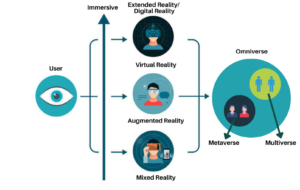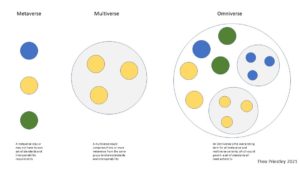The terms “Metaverse”, “Multiverse”, “Omniverse”, “Virtual Reality”, “Augmented Reality”, “Mixed Reality”, “Extended Reality”, “Digital Reality”, and “Immersive Reality” are being muddled and thrown around a lot. All these technologies are reality technologies that either enhance or replace a real-life environment with a simulated or virtual one. These technologies offer an innovative way to immerse users engagingly and interactively and to provide a better personal experience.
 Figure: The world of immersive technologies in the new universe.
Figure: The world of immersive technologies in the new universe.
Metaverse
Metaverse uses various types of reality technologies to create/get access to a virtual space wherein a user can do almost everything such as go for a walk, listen to music, play video games, visit non-fungible tokens (NFT) museums and much more. Users can create and explore alongside other people who aren’t necessarily in the same physical space. Users have to create their digital avatars, which humans control during their interaction with the metaverse. It can be experienced synchronously by an unlimited number of users, each having an individual sense of presence in the metaverse.
Multiverse
Multiverse also uses various types of reality technologies to create/get access to a virtual space wherein a user can do everything such as going for a walk, listening to music, playing video games, visiting non-fungible tokens (NFT) museums and much more. but, one basic distinction is that they can perform only one task at any particular time. For example, a game that has been developed using artificial intelligence, virtual reality and augmented reality. Such a game gives us a sense of the 3D world around us, but you can use the platform only to play the game. So, in a multiverse, while playing the game, you can check the marketplace of the game, but it won’t be possible to enter an NFT museum at the same time. In simple words, a multiverse can be defined as a set of different virtual universes, and you can switch between the universes to do different things. So, multiverse projects, such as game platforms, are ideal virtual worlds within the framework of their ecosystems, but they lack a convergence with the real world. Furthermore, their interconnectivity with other multiverse projects is limited because they are mostly isolated ecosystems.
Omniverse
The omniverse is a collection of every single universe, multiverse, and metaverse. The omniverse becomes the overarching term that covers not only the single metaverse but also the other multiverses that exist or will exist.

Figure: A proposed hierarchical structure of the Metaverse [1]
Virtual Reality (VR)
Virtual reality uses a reality technology (like a VR headset device) to make the environment completely virtual. It simply means, VR only enhances a fictional reality and VR users are controlled by the VR device.
Example: The use of Oculus Rift, HTC Vive, or Google Cardboard.
Augmented Reality (AR)
Augmented reality uses a reality technology (like a smartphone with AR mobile app) to either enhance or replace a real-world setting with a simulated or virtual one. AR enhances both the virtual and real world. AR users can control their presence in both the real and virtual worlds.
Example: IKEA Place mobile app.
Mixed Reality (MR)
Mixed reality uses a combination of reality technologies by combining the elements of both AR and VR, real-world and virtual-world (digital objects) interact.
Example: Microsoft’s HoloLens is one of the most notable early mixed reality apparatuses.
Extended Reality (XR) / Digital Reality (DR)
Extended reality is an umbrella term that covers all of the various technologies that enhance our senses, whether they’re providing additional information about the actual world or creating unreal, simulated/virtual worlds for us to experience. It includes Virtual Reality (VR), Augmented Reality (AR) and Mixed Reality (MR) technologies. In general, it is also called “Digital Reality (DR)”. XR refers to all real-and-virtual environments generated by computer/mobile technology and wearables. The ‘X’ in XR is a variable that can stand for any letter.
Immersive Reality (IR)
Immersive reality is also called “immersive technology” which creates an immersive experience for users. It is a reality technology that either enhances or replaces a real-life environment with a simulated or virtual one. Immersive reality can be either “virtual reality”, “augmented reality”, “mixed reality”, and/or “extended reality”.
We hope this article has provided some clarity to the reader on the various terms that get thrown around when talking about the metaverse. The readers are invited to go through the following links for further details on this fascinating and emerging technology.
Further Reading:
- https://www.metapunk.co.uk/metablog/7-2021-the-metaverse-the-multiverse-and-the-omniverse
- https://www.splunk.com/en_us/data-insider/what-are-augmented-reality-and-virtual-reality.html
Article contributed by Dr Mithileysh Sathiyanarayanan, Founder & CEO, MIT Square, London





